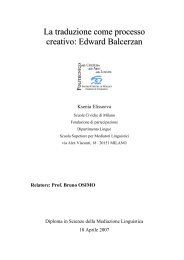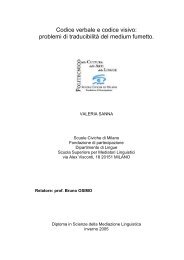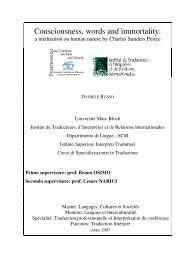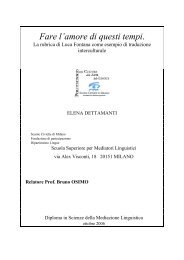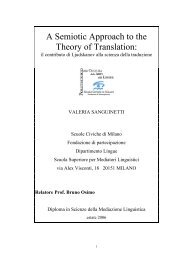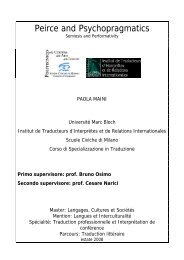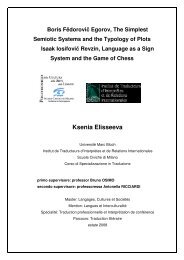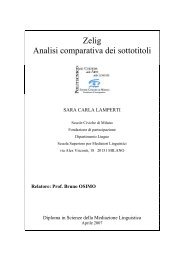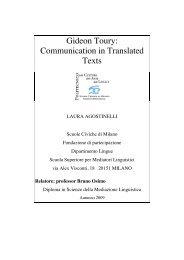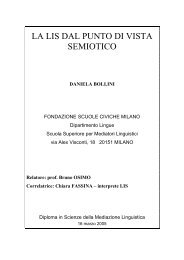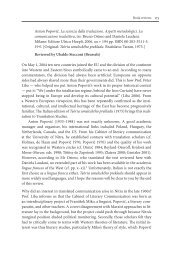Relatore: Professor Bruno OSIMO - Bruno Osimo, traduzioni ...
Relatore: Professor Bruno OSIMO - Bruno Osimo, traduzioni ...
Relatore: Professor Bruno OSIMO - Bruno Osimo, traduzioni ...
You also want an ePaper? Increase the reach of your titles
YUMPU automatically turns print PDFs into web optimized ePapers that Google loves.
7. CONCLUSION<br />
The purpose of the present research was to portray think-aloud protocols<br />
as the best suited method for collecting data and investigating the human<br />
mind processes, particularly the translation process. At the same time, it<br />
presents the problems this verbalizing procedure entails and the limits<br />
researchers meet, when trying to compare different TAP experiments.<br />
According to cognitive psychological literature, verbal reports yield valid<br />
and reliable data on human thought processes. However, cognitive psychology<br />
has always dealt mainly with well-defined problem-solving tasks, for which it<br />
is possible to determine a priori correct solutions and problem-solving<br />
strategies. Translating, in turn, as a creative and subjective process, represents<br />
an fuzzy form of problem-solving. Furthermore, translating and thinking<br />
aloud are both verbal tasks, which means that they may draw on the same<br />
memory resources, and thus interfere with each other.<br />
To avoid these kinds of problems, researchers tried to use joint<br />
translating as a method of data elicitation. Although the studies comparing<br />
think-aloud protocols and joint translation have offered interesting results,<br />
particularly with regard to didactic applications, these experiments contain<br />
other variables, which makes it impossible to state that joint translating would<br />
be a better method for studying translating than thinking aloud.<br />
In both cases, it is important to remember that subjects are asked to<br />
verbalize their thoughts; this is not a simple task, because it requires them to<br />
reorganize their mental discourse into an oral one. And even if experimenters<br />
recommend them to say things just as they come to mind, they’ll probably try<br />
to communicate their mental ideas in a way other people would understand.<br />
Moreover, many other elements, such as the subjects’ personal history,<br />
emotional factors, the effect of the experimental situation, fear of failure etc.<br />
(cf. section 7), may alter the results of TAP experiments.<br />
More attention should be paid to identifying and isolating these variables<br />
by, for example, using pre-experimental testing; then, they should be carefully<br />
taken into account when examining the results of verbal reports. The<br />
66



